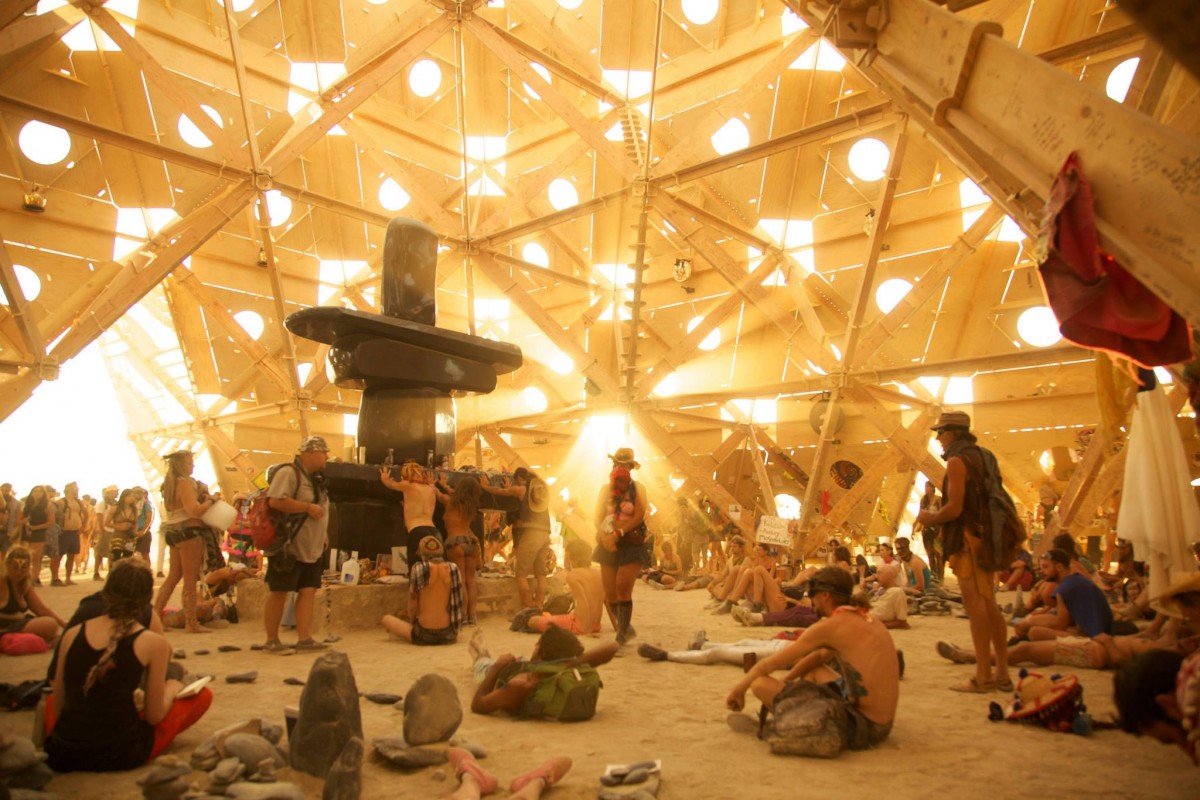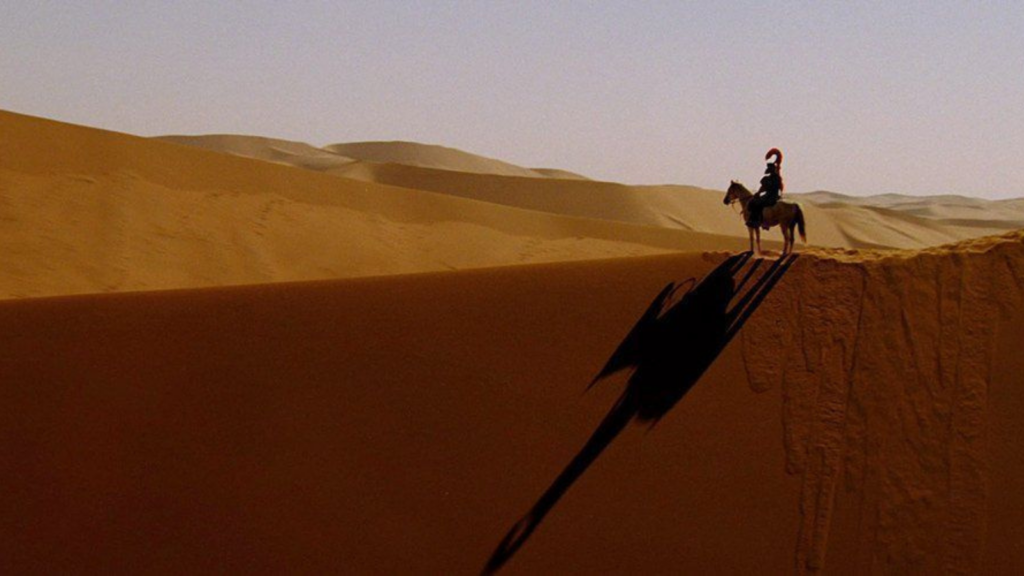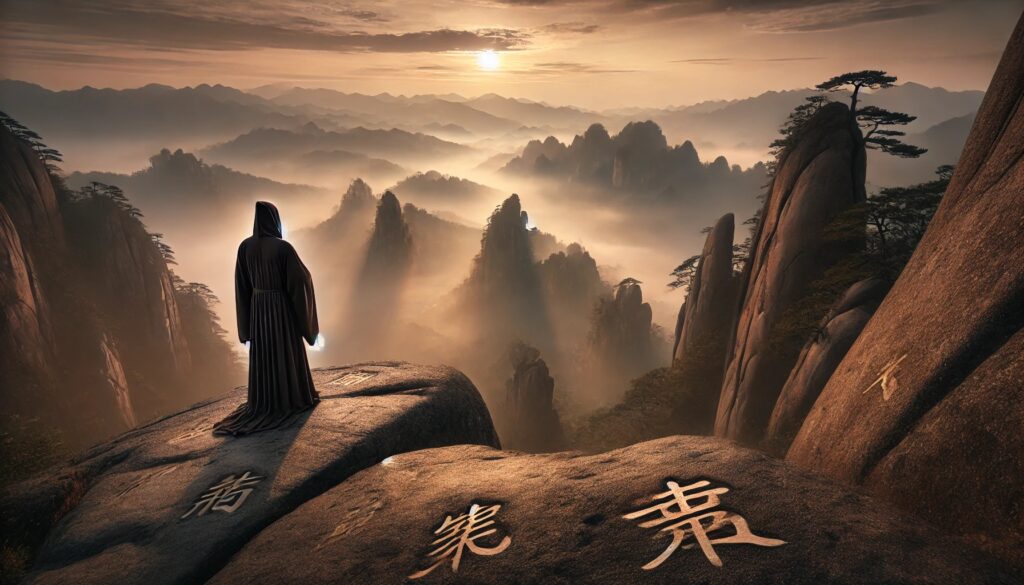The following article originally appeared on ianmack.com.
“The Temple rises apart from Black Rock City, an oasis of calm out in the deep playa that stands resolute, able to bear what participants bring and to be what we need at the moment we call on it. Behind the Temple stands a group that has quietly watched over those structures each year since 2002. The main duty of the Temple Guardians is to protect the Temple and those who visit it. We abide with love for the Temple and everything that it represents.” – The Temple Guardians
In 2011, I fell in love. Not with a person, but a structure: The Temple of Transition.
It was my third year at Burning Man and the first year I understood the Temple. The original Temple of Mind, created by David Best and Jack Haye, appeared in 2000. When their friend and fellow builder Michael Hefflin died in a motorcycle crash prior to the burn, the art installation became a memorial to him. Spontaneously, other participants began leaving memorials to their own loved ones – and a playa tradition was born.
“It was just an obvious absence,” remarked David. “There was a void that no one really noticed. They got the porta potties, they’ve got the police station, they’ve got the medical and they’ve got the Man. They just didn’t have a place for grief.”
In my early 20′s I discovered Buddhism and the noble truth: life is impermanent. The only constant is change. Meditation retreats and intellectual understandings of death soon followed. Stoic by nature, I now had the cultural and philosophical language to keep life at a distance. Dying is easy, I thought, when you’re not attached. But these beliefs remained untested.
In 2009, I avoided the deathbed of my wife’s dying Aunt Lily. I fled to the desert of Nevada and my first Burning Man. I mostly avoided the Temple until the final day, until my shame was unbearable. As the sun rose and the shadows stretched, I realized Lily taught me my inability to face death. Whether she knew it or not.
I found a precious space of wood and wrote: In Remembrance of Aunt Lily.
The Temple is at the edge of where we bring order to chaos. It is where our community goes to unburden themselves. – Moze
In 2010, I was given the name Vision Weaver and served my first year as Temple Guardian. Much like the Temple, the Guardians arose from an absence – or more poetically, an un-articulated longing. With the role came duty: to hold the sacred space and embody the love and acceptance of the Temple. Most of all, to bear witness to the grief of being human.

I fell in love. But it was a different kind of love than I had ever experienced. It wasn’t a love of possession or lust. What I had found in the desert, within myself, was agape.
Agape, an ancient Greek word, has been expressed by Mike Ventimiglia in Christian terms as: “a type of love that is not intended to satisfy oneself, at least not directly. And this love not only saves us from death in childhood; it saves us from a narrowness and smallness of purpose as we grow. Agape is the love of transformation.”
For me, I called it devotion.
On the final morning when She was to burn, when thousands of onlookers would sit rapt in silence around Her, I peddled madly back to camp to borrow a friend’s video camera. The sky exuded purple, while a growing orb of light waxed from the horizon. Carl Jung named this lux moderna, the first light after one’s journey through the underworld.
I shot as if possessed, capturing whatever I could before the sun crested and the Temple crew began politely, but firmly, asking me to leave. That night, I served on the Guardian perimeter, charged with watching the fire dance in the eyes of my fellow burners. Fitting, because I couldn’t bear turning around to watch Her fall.
The entire week I didn’t cry. It was only weeks later, as I sat at my desk and opened the footage for the first time, that I wept, instantly. Soon I completed the love letter Dear Temple.
Life does not feed life. Life is on the receiving end of life. Always. It’s death that feeds life. – Stephen Jenkinson
In the summer of 2012, three weeks before the burn, I met a griefwalker. He has been called many names, A Great Rememberer, The Angel of Death, though most call him Stephen Jenkinson. After seeing my love letter, a friend implored me to join his Orphan Wisdom school, which is how I found myself amid the crackling firelight and faces of fellow scholars, wondering how things came to be as they are.
Though I never spoke these words that night, a question burned hot on the tip of my tongue: why did I never know I needed the Temple?
His answer: Because even the gone, is gone.
From Stephen I learned the language of grief along with its necessity. I learned grief is a skill, one that is far from inevitable in a grief-soaked time. And I learned grief is not something you get through and get over. “Grief is the willingness to be claimed by a story bigger than the one you wish for,” he told me. “In that sense, grief is a willingness to know. Grief is the human angel in the world.”
With those words I headed to my fourth Burning Man, adrift in my heartbreak. I signed up as a Temple Guardian, but felt like a fraud. I wanted it both ways: to revel in my consumption and bow into service. At least at the time, they appeared mutually exclusive. I vowed never to return until I knew why.
There is no silence like the dead of winter. It’s New Year’s eve, and the final ceremony for our meditation retreat, buried in the dark forests of rural Ontario. Our Buddhist teacher Michael Stone has secretly given various bells and chimes to students throughout the room. He leads us through a cleansing practice: hands carving the shape of an ensō in the sky.
An enso is that classical form, a circle painted by single brush stroke. I push out all that no longer serves me. Goodbye doubt. Goodbye shame. Goodbye dilemma.
As the seconds gather towards midnight, Michael states “Begin.” In the candlelit room, a chime rings out, hanging delicately in the air. Then a bell in the far corner. Then another chime in the opposite end. Faster and faster. The rhythm unseen but the shape unmistakable.
A circle.
No.
A spiral.
Suddenly, I am back in the Temple of Transition. I hear the Gamelatron reverberating in my ears, the Indonesian instrument of gongs and cymbals that adorns her walls. I smell the dust, eyes burning from the light streaming in through Her arches. The gongs circle, sweeping the edges of those gathered around me, generating the other side of the portal. Time collapses, the fallacy of linearity laid bare.
As the cacophony rises, both in the meditation hall and the playa, all my thoughts are obscured but one: Why do you need to go back?
A tear slides down my cheek. My lips curl. Agape.
I know why I will go back.
I will make a film about the Guardians.
Dying changes what life means if you are willing for it to be so, and only if you are willing to pay, to lose your old ideas, often by handfuls at a time. Dying must be allowed to change everything. – Stephen Jenkinson
In 2013, camera in hand, I arrived on the playa with clear intent. No more was there a dilemma between spectator and participant, between giver and taker. I came to make an offering to the Guardians. But there was something I had to do first.
It was Milan Kundera who wrote “Loves are like empires. When the idea they are founded on crumbles, they, too, fade away.” That year marked the death of my marriage. Our story had crumbled in the face of radical uncertainty, and taken with it my adolescent faith in the commitment of forever.
On Thursday, I dressed in white from head to toe, prepared to make the solemn trek to the Temple of Whollyness. In my hands, I clutched the leftover cards and photographs from our relationship that would soon burn.
Before leaving the tent, I consulted the Zen tarot deck. Osho, always the trickster, never failed to offer a wry perspective. I shuffled the deck, slid my fingers over the cards, until feeling the tug of intuition. I flipped over: Celebration. I read the first line of his commentary:
“Life is a moment to celebrate, to enjoy. Make it fun, a celebration, and then you will enter the temple.”
I choked back a sob.
I had the opening quote for my film.
The rest of the week was a characteristic blur. I remember most the brilliant sunlight piercing through the Temple walls, visible through the thick dust in the air. I remember quiet footsteps as I followed various Guardians on their shifts – most uneventful, at least on the surface. And I remember my final epiphany, as I watched the Temple of Whollyness burn from my camera lens.
The Guardian is a role.
Living cultures throughout the world have known the importance of Guardians – those that hold the space for ritual and rites of passage, for death and the welcoming of new life. And just as cultures are born, surely they are also subject to the impermanence of all things. They too, must die.
In a time of reckless consumption, we trespass on the future, endangering the continuity of Life itself. Thankfully, but with no less heartbreak, the dominant culture has begun its terminal swoon. This is not a tragedy, but a recognition that the dying time as arrived.
Before me, the Temple spires collapse in a shower of embers.
What we need, beyond new ideas, new strategies, new technologies, and new stories – is human beings willing to sit by the deathbed, without turning away. We need human beings willing to learn the death, as the last gift of the culture, and the wisdom bequeathed to those who will come after us and wonder: what did they do, once they knew?
We are in dire need of the Guardians.
Acknowledgements
I am deeply indebted to Carousel and the rest of the Temple Guardian leadership crew who trusted me to make this film. I remain in awe and gratitude to Hiatus for allowing the use of his music, along with composing an original track “Becoming” for the opening sequence. Thanks also to Roy Two Thousand and Seven Clouds for some additional cinematography , and Jeremy Therrien for the sound design.
And finally, thank you to David Best and all the Temple builders throughout the years who have shattered me and countless others. May we see in our shared brokenness the brokenness and beauty of the world – and as we piece ourselves back together, may we not forget the world, again.
Please support my work, bringing films like these to the world.














